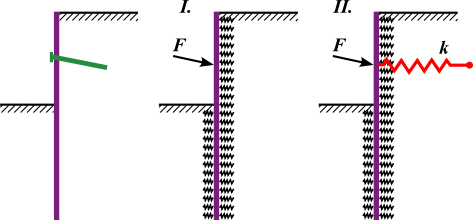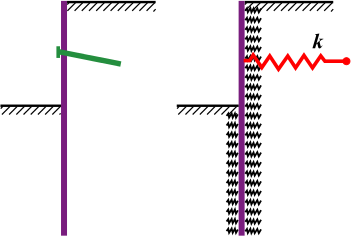Sheeting Check
The program verifies the input structure using the method of dependent pressures or using the spring method according to JGJ 120-2012. The load applied to the structure is derived from its deformation, which allows us to realistically model its behavior and provides cost-effective designs. The analysis correctly accounts for the construction process such as individual stages of progressive construction of the wall (stages of constructions) including an gradual evolution of the deformations and a post-stressing of the anchors. The program can model any kind of braced sheeting too.
The use of the method of dependent pressures requires determination of the modulus of subsoil reaction, which is assumed either linear or nonlinear.
The program also allows the user to check internal stability of the anchorage system.
The actual analysis is carried out using the deformation variant of the finite element method. Displacements, internal forces, and the modulus of the subsoil reaction are evaluated at individual nodes.
The following procedure for dividing the structure into finite elements is assumed:
- First, the nodes are inserted into all topological points of a structure (starting and endpoints, points of location of anchors, points of soil removal, points of changes of cross-sectional parameters).
- Based on selected subdivision the program computes the remaining nodes such that all elements attain approximately the same size.
A value of the modulus of subsoil reaction is assigned to each element - it is considered as the Winkler spring of the elastic subsoil. Supports are placed onto already deformed structure - each support then represents a forced displacement applied to the structure.
In the construction stage, where are introduce, prestressed anchors are modeled as a force. (variant I in Fig). In other construction stages the anchors are modeled springs of stiffness k (variant II. in Fig) and force:
 Model of prestressed anchor
Model of prestressed anchor
Non-prestressed anchors are model always as spring in all construction stages. The force in the anchor is computed from the deformation of the structure and the anchor stiffness:
 Model of non-prestressed anchor
Model of non-prestressed anchor
The change of anchor force due to deformation is provided by:
![]()
![]()
where: | v | - | horizontal distance between the anchors |
Δ w | - | deformation increment the point of anchor application | |
E | - | anchor Young’s modulus | |
A | - | anchor cross-sectional area | |
l | - | anchor length | |
k | - | anchor stiffness | |
α | - | anchor inclination |
Literature:
Hurych, P.: Metoda zavislych tlaku. Sbornik konference "Automatizacia projektovania", Vysoke Tatry, 1978.